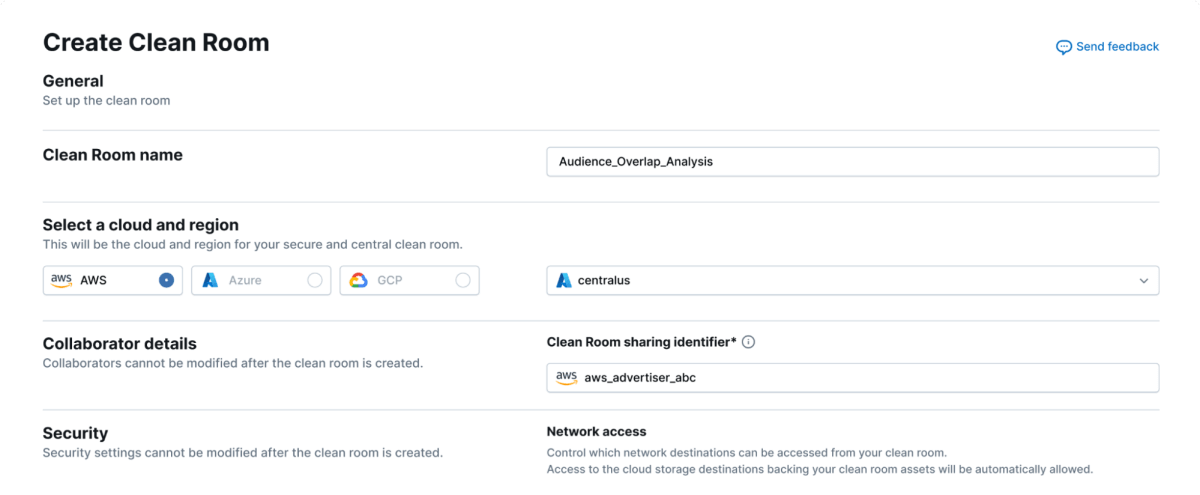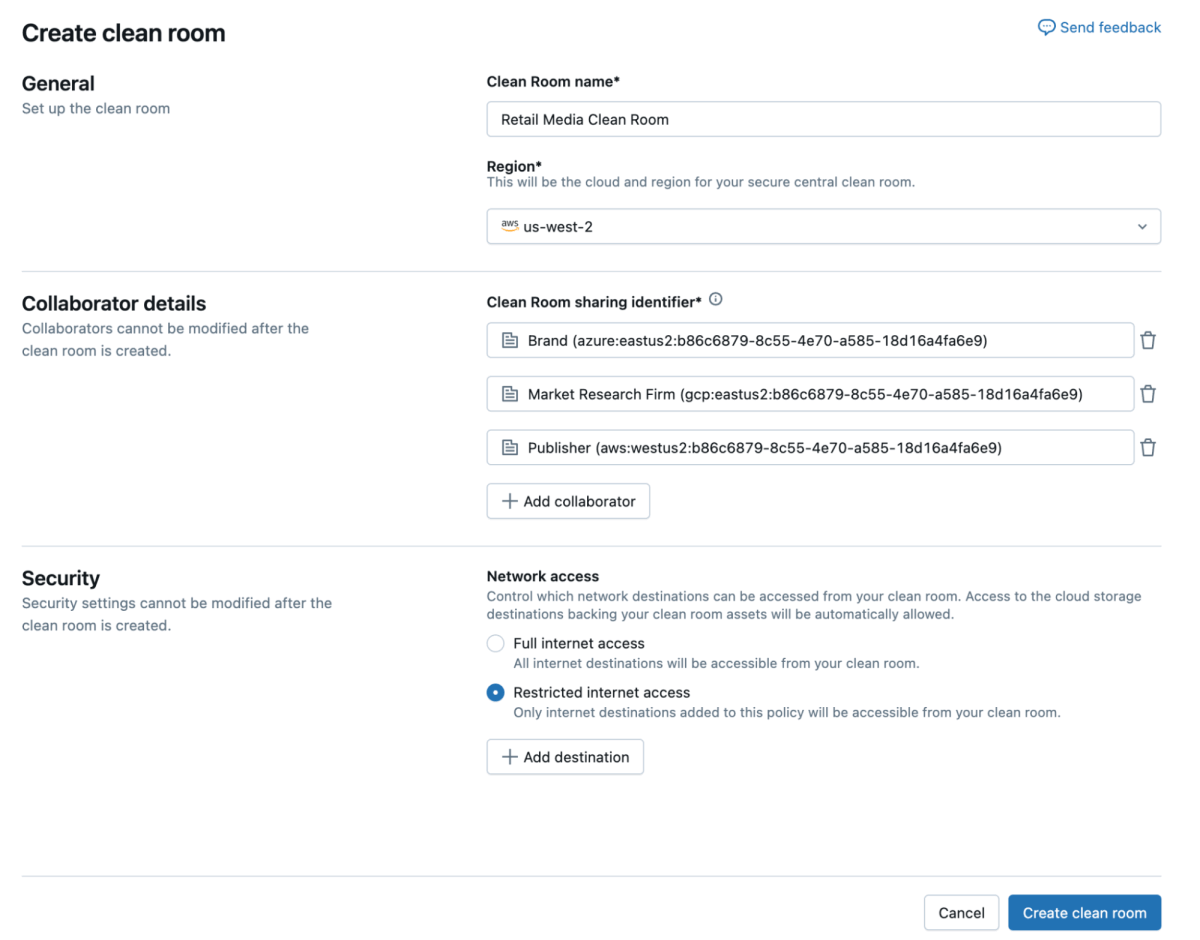Databricks Clear Rooms allows clients and companions to investigate their mixed knowledge, with out revealing delicate uncooked knowledge to at least one one other. Because the GA launch on AWS and Azure in February 2025, we have seen many shoppers undertake clear rooms in Promoting, Monetary Companies, Healthcare and plenty of different industries. On this weblog publish we spotlight how main identification companions are leveraging clear rooms for privateness secure identity-resolution, in addition to new collaboration and privateness functionalities that clients have requested for.
Id Decision in Clear Rooms
We’re excited to introduce an development in identification decision: safe, cloud-native identification decision in Databricks Clear Rooms. This innovation empowers companions and entrepreneurs to confidently and securely match and enrich datasets utilizing frequent identifiers—all with out exposing uncooked PII or shifting knowledge off-platform.
To allow this functionality, we’re thrilled to companion with business leaders together with Epsilon, Deloitte, LiveRamp, and Acxiom. Collectively, we’re making it simpler for organizations to unify fragmented data, join associated knowledge, and unlock richer insights—all inside a privacy-centric setting.
Take into account an e-commerce model collaborating with a significant identification supplier to resolve hashed buyer emails, postal knowledge, and machine touchpoints, to an individual or family primarily based identification. With this new functionality, each events can convey knowledge right into a clear room and carry out identification decision in place—safely and effectively.
This strategy marks a brand new period in knowledge collaboration: one the place delicate knowledge by no means leaves the platform, identification matching occurs seamlessly, and insights are generated with out compromise. Databricks is proud to energy this shift, providing a scalable setting that redefines what’s potential for clean-room collaboration and identification decision.
Clear Rooms on Google Cloud Platform (GCP)
Clear Rooms is now usually out there on Google Cloud, enabling seamless cross-cloud collaborations with full flexibility. Beginning in the present day, clients create a central clear room setting on GCP and collaborate with companions throughout AWS, Azure, or another knowledge platform. This aligns with our “Any cloud, any platform” philosophy: “Collaborate in a privacy-centric setting throughout clouds, areas and knowledge platforms with out requiring knowledge motion”.

For instance, a big retailer on GCP and a shopper model on AWS, seeking to companion and analyze the effectiveness of their joint advertising efforts. The retailer can now spin up a clear room on GCP and invite the model to securely contribute their engagement metrics from current marketing campaign knowledge. By combining this with the retailer’s buyer buy knowledge, each events can collaboratively determine traits and measure the affect of promotions—with out ever sharing or exposing their uncooked knowledge to one another.
Different clear room suppliers restrict you to collaborate on their cloud or platform. With Databricks Clear Rooms, you keep away from cloud silos and vendor lock-in and knowledge stays in place through Delta Sharing, and also you solely share anonymized outputs.
Multi-Social gathering Collaboration
Clear Rooms now help a number of collaborators in a single room. Beforehand, every clear room was successfully two-party solely; now you may invite as much as 9 different organizations (i.e., 10 complete). These collaborators will be on totally different clouds, areas, or knowledge platforms, but work collectively in a single central setting. This unlocks “Any scale, any belief stage” and helps many-to-many collaborations with fine-grained entry controls and orchestration.

Take into account a retail advertising situation: a retailer, its promoting model, and a market analysis agency wish to construct a mixed buyer insights mannequin. All three events convey proprietary knowledge and code. With multi-party clear rooms, the retailer can invite each companions into one clear room, share obligatory tables, and run joint analytics. As an illustration, the retailer’s e-commerce knowledge, the model’s buyer knowledge, and the researcher’s survey knowledge will be joined and analyzed collectively, with none get together ever seeing one another’s uncooked tables.
By enabling multi-party collaboration with fine-grained governance, you unlock richer insights that require greater than two organizations.
Versatile Privateness Approvals
Clear Rooms now help safe self-runs, permitting collaborators to add and run their personal notebooks with express approval from different clear room contributors. Beforehand, notebooks may solely be run by the different get together, with approval implied by clicking the run button.
For instance, Hospital A needs to run a pocket book that computes joint statistics on shared affected person knowledge. They’ll now add and run that pocket book themselves — however solely after Hospital B explicitly approves the code. This balances flexibility with governance: knowledge by no means strikes with out consent, code by no means runs with out evaluation, and output all the time stays with the runner. For purchasers, this implies sooner iteration, extra autonomy, and full auditability — all inside a trusted collaboration setting.
Code governance is important in knowledge collaboration. These approval options guarantee no code runs with out consent. You acquire an audit path of who authorised what (no extra shock queries), and also you cut back the chance of malicious or misguided code.
Walkthrough: Placing It All Collectively
Let’s stroll by means of a high-level instance utilizing all three options:
- Create the Clear Room (on GCP): Knowledge Platform Lead (let’s name him Alex) units up a brand new clear room on Google Cloud. She invitations two collaborators by sharing their identifiers (AWS and Azure companions)
- Add Knowledge: Every get together provides tables to the clear room. For instance, the AWS, GCP, and Azure datasets are all uploaded within the clear room. There at the moment are three collaborators on this room—Alex and two invitees. All three can see the shared metadata, however none can see others’ uncooked knowledge.
- Add Notebooks: Alex uploads evaluation notebooks (e.g., Python scripts for ML, SQL for joins). All events should explicitly approve the pocket book earlier than Alex can run it.
- Run the Evaluation: Alex now kicks off the pocket book run. As a result of it’s authorised, the serverless clean-room cluster executes the code. The run produces output tables (non permanent read-only outcomes) in Unity Catalog. For instance, a joined buyer phase desk is generated so the pocket book executor can extract mixture insights.
- Assessment and Iterate: Alex views the aggregated outputs. If new evaluation is required, they repeat, including or updating notebooks beneath the identical governance.
This demo reveals how cross-cloud companions (on GCP, AWS, and Azure) can collaborate in a single shared clear room. It highlights multi-party collaboration, seamless knowledge sharing through Delta Sharing, and the flexibility for companions to add and run their very own notebooks, with express approvals. The end result: safe, auditable joint evaluation throughout clouds and organizations, with no raw-data publicity.
What’s Subsequent?
Databricks Clear Rooms proceed evolving, however the core worth stays: making knowledge collaboration potential with out compromising privateness, efficiency, or platform flexibility. We invite you to discover these new capabilities and share suggestions. Able to dive deeper? Try the next classes to be taught extra about Clear Rooms on the Knowledge and AI Summit, June 9-12, 2025, in San Francisco

